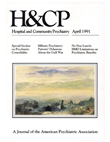Prevalence of Dual Diagnoses of Mental and Substance Abuse Disorders in General Hospitals
Abstract
Data from a 1980 discharge survey of general hospitals were analyzed to determine the prevalence of cases with coexisting diagnoses of mental and substance abuse disorders. Twelve percent of total cases (or 208,000 episodes) had dual diagnoses, a proportion similar to that found in another analysis of 1985 data. Of these cases, 55.5 percent had a primary diagnosis of an alcohol or drug disorder, most commonly alcohol- or drug-induced organic brain syndrome. Thirty-four percent of cases with a primary diagnosis of mental disorder had depressive neurosis, 24 percent had psychosis, and 19 percent had personality disorder. An additional 18.9 percent of all cases had two or more mental or substance abuse disorders. Dual-diagnosis cases had a shorter mean hospital stay than cases with mental disorder only.
Access content
To read the fulltext, please use one of the options below to sign in or purchase access.- Personal login
- Institutional Login
- Sign in via OpenAthens
- Register for access
-
Please login/register if you wish to pair your device and check access availability.
Not a subscriber?
PsychiatryOnline subscription options offer access to the DSM-5 library, books, journals, CME, and patient resources. This all-in-one virtual library provides psychiatrists and mental health professionals with key resources for diagnosis, treatment, research, and professional development.
Need more help? PsychiatryOnline Customer Service may be reached by emailing [email protected] or by calling 800-368-5777 (in the U.S.) or 703-907-7322 (outside the U.S.).



